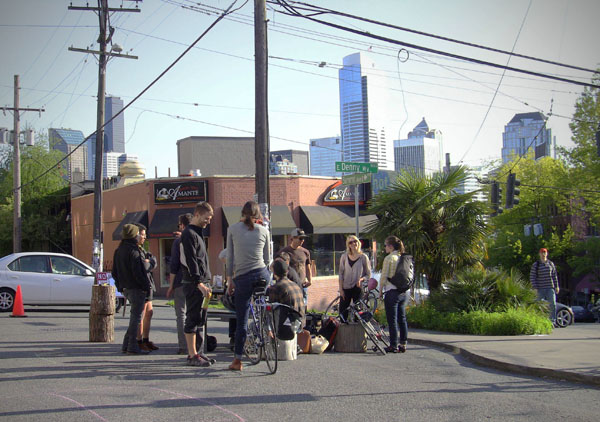S400: Lighter, Quicker, Cheaper*
Last month, we took a street for an evening. We acquired no permits, held no visioning meetings, received no funding. We took an unloved, underutilized piece of public right-of-way and transformed it into a place of potential, a pocket of social interaction. Maybe a touch grandiose, sure, but we did temporarily add life to a street in a way that’s not normally allowed.
This intervention was grounded in three findings:
- Cities are broke – Budgets are contracting and we have to reconceive our expectations of what the city can/should provide for the public realm.
- Streets are underutilized – 33% of Seattle is in the public right-of-way. Streets like the Summit stub (see photo above) have a capacity of 2000 cars/hr, yet are used by less than 100 cars/hr.** When land is underused and redundant (especially public land), we should look for better uses of that land.
- Our space and time are precious – The land underneath the Summit Stub is worth about $500,000.*** Is that really the best investment of our limited resources and space? Should we have to wait months or years to make it better?
So, through action, we propose a simple fix:
- Change the process: For less than the current price of permit review, we transformed the space. With communally donated parts and labor, we don’t need millions of dollars to make great urban spaces.  The city just needs to designate space and let the neighborhood do the rest.
- Change the mindset: We need to ditch the notion that the city is a fixed entity. The life of a city is dynamic and the way in which we plan for and use our public space should reflect that understanding. We need a system that allows for temporary action, for phased development, for experimentation. Maintaining the status quo may be easier and won’t upset anyone, but it’s also inefficient and inequitable. Worst of all, it’s boring.
On June 14th, we’ll be transforming the Summit stub again. As a real time case study, we’re learning about how a dead space can be converted to a living one.  Lighter, quicker, and cheaper. Show up and help shape the future of our public realm. More information at facebook.com/rpcollective.
>>>
Seth Geiser is an urban designer who clearly has some time on his hands. Kirk Hovenkotter is an urban planner working professionally at a city and likes, nay loves, transit.
* A useful phrase, cribbed from pps.org/reference/lighter-quicker-cheaper-2-2
** As observed by semi-rigorous, probably non-scientific traffic counts
***Based on a rate of $125/sqft for lots adjoining the site


